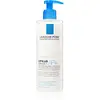La Roche-Posay Lipikar Syndet Ap+ : Ultra-Gentle Cream Wash Versus CeraVe Diabetics' Dry Skin Relief Cleansing Wash
What's inside
What's inside
 Key Ingredients
Key Ingredients

 Benefits
Benefits

 Concerns
Concerns

 Ingredients Side-by-side
Ingredients Side-by-side

Water
Skin ConditioningGlycerin
HumectantSodium Laureth Sulfate
CleansingPEG-200 Hydrogenated Glyceryl Palmate
CleansingCoco-Betaine
CleansingPolysorbate 20
EmulsifyingPEG-7 Glyceryl Cocoate
EmulsifyingNiacinamide
SmoothingAcrylates Copolymer
Butyrospermum Parkii Butter
Skin ConditioningButter
Skin ConditioningCitric Acid
BufferingCocamide Mea
EmulsifyingDisodium EDTA
Mannose
HumectantPolyquaternium-11
Sodium Benzoate
MaskingSodium Chloride
MaskingSodium Hydroxide
BufferingStyrene
PerfumingVitreoscilla Ferment
Skin ConditioningWater, Glycerin, Sodium Laureth Sulfate, PEG-200 Hydrogenated Glyceryl Palmate, Coco-Betaine, Polysorbate 20, PEG-7 Glyceryl Cocoate, Niacinamide, Acrylates Copolymer, Butyrospermum Parkii Butter, Butter, Citric Acid, Cocamide Mea, Disodium EDTA, Mannose, Polyquaternium-11, Sodium Benzoate, Sodium Chloride, Sodium Hydroxide, Styrene, Vitreoscilla Ferment
Water
Skin ConditioningGlycerin
HumectantSodium Methyl Cocoyl Taurate
CleansingCoco-Betaine
CleansingSodium Cocoyl Isethionate
CleansingSodium Chloride
MaskingAcer Saccharum Extract
Skin ConditioningAcrylates/C10-30 Alkyl Acrylate Crosspolymer
Emulsion StabilisingCaprylyl Glycol
EmollientCarbomer
Emulsion StabilisingCeramide AP
Skin ConditioningCeramide EOP
Skin ConditioningCeramide NP
Skin ConditioningChlorphenesin
AntimicrobialCholesterol
EmollientCitrus Aurantium Dulcis Fruit Extract
MaskingCitrus Limon Fruit Extract
MaskingCoconut Acid
CleansingDisodium EDTA
Ethylhexylglycerin
Skin ConditioningGlyceryl Stearate
EmollientHydrogenated Coconut Acid
EmollientHydroxyethyl Urea
HumectantPEG-100 Stearate
PEG-150 Pentaerythrityl Tetrastearate
EmulsifyingPEG-30 Dipolyhydroxystearate
EmulsifyingPEG-6 Caprylic/Capric Glycerides
EmulsifyingPhenoxyethanol
PreservativePhytosphingosine
Skin ConditioningPolyquaternium-53
PPG-5-Ceteth-20
EmulsifyingSaccharum Officinarum Extract
MoisturisingSalicylic Acid
MaskingSodium Hydroxide
BufferingSodium Isethionate
CleansingSodium Lauroyl Lactylate
EmulsifyingTrideceth-6
EmulsifyingVaccinium Myrtillus Fruit Extract
Skin ConditioningXanthan Gum
EmulsifyingWater, Glycerin, Sodium Methyl Cocoyl Taurate, Coco-Betaine, Sodium Cocoyl Isethionate, Sodium Chloride, Acer Saccharum Extract, Acrylates/C10-30 Alkyl Acrylate Crosspolymer, Caprylyl Glycol, Carbomer, Ceramide AP, Ceramide EOP, Ceramide NP, Chlorphenesin, Cholesterol, Citrus Aurantium Dulcis Fruit Extract, Citrus Limon Fruit Extract, Coconut Acid, Disodium EDTA, Ethylhexylglycerin, Glyceryl Stearate, Hydrogenated Coconut Acid, Hydroxyethyl Urea, PEG-100 Stearate, PEG-150 Pentaerythrityl Tetrastearate, PEG-30 Dipolyhydroxystearate, PEG-6 Caprylic/Capric Glycerides, Phenoxyethanol, Phytosphingosine, Polyquaternium-53, PPG-5-Ceteth-20, Saccharum Officinarum Extract, Salicylic Acid, Sodium Hydroxide, Sodium Isethionate, Sodium Lauroyl Lactylate, Trideceth-6, Vaccinium Myrtillus Fruit Extract, Xanthan Gum
 Reviews
Reviews

Ingredients Explained
These ingredients are found in both products.
Ingredients higher up in an ingredient list are typically present in a larger amount.
Coco-Betaine is the natural version of Cocamidopropyl Betaine. It is often derived from coconuts.
Coco-Betaine is a surfactant, meaning it helps remove dirt and oil from the skin.
Disodium EDTA plays a role in making products more stable by aiding other preservatives.
It is a chelating agent, meaning it neutralizes metal ions that may be found in a product.
Disodium EDTA is a salt of edetic acid and is found to be safe in cosmetic ingredients.
Learn more about Disodium EDTAGlycerin is already naturally found in your skin. It helps moisturize and protect your skin.
A study from 2016 found glycerin to be more effective as a humectant than AHAs and hyaluronic acid.
As a humectant, it helps the skin stay hydrated by pulling moisture to your skin. The low molecular weight of glycerin allows it to pull moisture into the deeper layers of your skin.
Hydrated skin improves your skin barrier; Your skin barrier helps protect against irritants and bacteria.
Glycerin has also been found to have antimicrobial and antiviral properties. Due to these properties, glycerin is often used in wound and burn treatments.
In cosmetics, glycerin is usually derived from plants such as soybean or palm. However, it can also be sourced from animals, such as tallow or animal fat.
This ingredient is organic, colorless, odorless, and non-toxic.
Glycerin is the name for this ingredient in American English. British English uses Glycerol/Glycerine.
Learn more about GlycerinChances are, you eat sodium chloride every day. Sodium Chloride is also known as table salt.
This ingredient has many purposes in skincare: thickener, emulsifier, and exfoliator.
You'll most likely find this ingredient in cleansers where it is used to create a gel-like texture. As an emulsifier, it also prevents ingredients from separating.
There is much debate on whether this ingredient is comedogenic. The short answer - comedogenic ratings don't tell the whole story. Learn more about comegodenic ratings here.
The concensus about this ingredient causing acne seems to be divided. Research is needed to understand if this ingredient does cause acne.
Scrubs may use salt as the primary exfoliating ingredient.
Learn more about Sodium ChlorideSodium Hydroxide is also known as lye or caustic soda. It is used to adjust the pH of products; many ingredients require a specific pH to be effective.
In small amounts, sodium hydroxide is considered safe to use. However, large amounts may cause chemical burns due to its high alkaline.
Your skin has a natural pH and acid mantle. This acid mantle helps prevent harmful bacteria from breaking through. The acid mantle also helps keep your skin hydrated.
"Alkaline" refers to a high pH level. A low pH level would be considered acidic.
Learn more about Sodium HydroxideWater. It's the most common cosmetic ingredient of all. You'll usually see it at the top of ingredient lists, meaning that it makes up the largest part of the product.
So why is it so popular? Water most often acts as a solvent - this means that it helps dissolve other ingredients into the formulation.
You'll also recognize water as that liquid we all need to stay alive. If you see this, drink a glass of water. Stay hydrated!
Learn more about Water